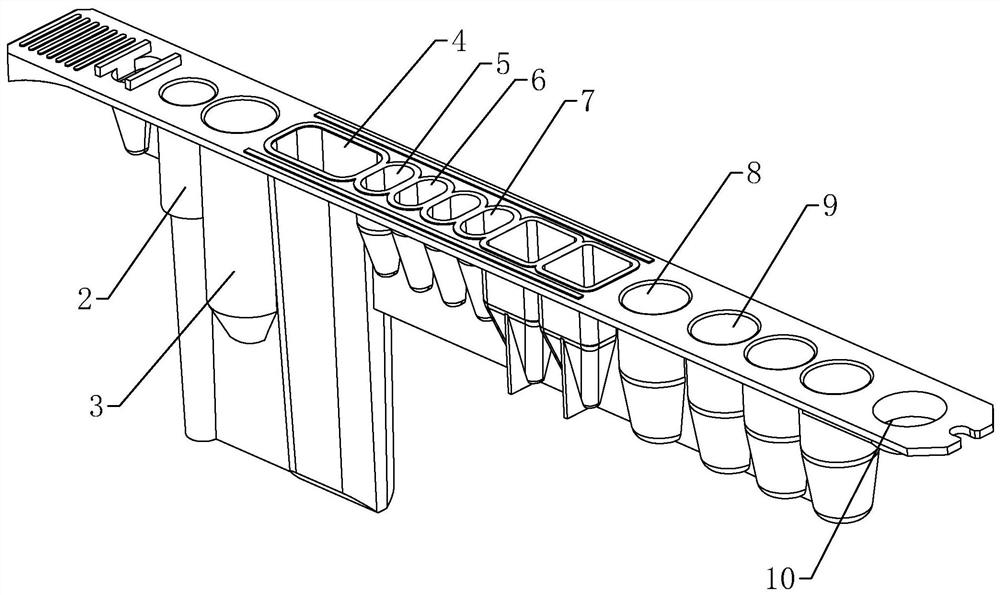Cardiac troponin I detection reagent, preparation method and cardiac troponin I detection kit
A technique for cardiac troponin and detection kits is applied in the preparation of the detection reagents, cardiac troponin I detection reagents, and cardiac troponin I detection kits, and can solve the problem of reduced sensitivity, material loss, troponin I antibody fully reacts and other problems to achieve the effect of increasing the reaction area, improving the reaction speed and uniform distribution
- Summary
- Abstract
- Description
- Claims
- Application Information
AI Technical Summary
Problems solved by technology
Method used
Image
Examples
preparation example 1
[0076] Preparation Example 1: The preparation of the buffer solution specifically includes the following configuration steps.
[0077] 1. Preparation of buffer solution 1: Weigh 14.8g of triethanolamine and 5.8g of sodium chloride, dissolve them in 100mL of purified water, adjust the pH value to 7.3 with 4mM hydrochloric acid and 4mM sodium hydroxide, and dilute to 1000ml with purified water, Filter with a 0.22 μm filter membrane to obtain buffer solution 1.
[0078] 2. Preparation of buffer 2: Weigh 75.0 g of glycine, dissolve it in 100 mL of purified water, dilute to 1000 ml with purified water, and then filter through a 0.22 μm filter membrane to obtain buffer 2.
[0079] 3. Preparation of buffer 4: Weigh 10.0g of sodium tetraborate decahydrate, dissolve it in 100mL of purified water, adjust the pH value to 11.0 with 4mM hydrochloric acid and 4mM sodium hydroxide, and dilute to 1000ml with purified water, then use 0.22μm filter membrane to obtain buffer 3.
[0080] 4. Pre...
preparation example 2
[0085] Preparation example 2: the preparation of the buffer solution, specifically including the following configuration steps.
[0086] 1. Preparation of buffer solution 1: Weigh 15.1g of triethanolamine and 6.0g of sodium chloride, dissolve them in 100mL of purified water, adjust the pH value to 7.6 with 4mM hydrochloric acid and 4mM sodium hydroxide, and dilute to 1000ml with purified water, Filter with a 0.22 μm filter membrane to obtain buffer solution 1.
[0087] 2. Preparation of buffer 2: Weigh 75.0 g of glycine, dissolve it in 100 mL of purified water, dilute to 1000 ml with purified water, and then filter through a 0.22 μm filter membrane to obtain buffer 2.
[0088] 3. Preparation of buffer 4: Weigh 7.0g of sodium tetraborate decahydrate, dissolve it in 100mL of purified water, adjust the pH value to 9.0 with 4mM hydrochloric acid and 4mM sodium hydroxide, and dilute to 1000ml with purified water, then use 0.22μm filter membrane to obtain buffer 4.
[0089] 4. Pre...
preparation example 3
[0094] Preparation Example 3: The configuration method of the buffer solution. The difference from Preparation Example 1 is that the configuration method of the buffer solution 5 is as follows: Weigh 300 g of dipotassium hydrogen phosphate and 120 g of potassium dihydrogen phosphate and dissolve them in 100 mL of purified water, pass through 4 mM hydrochloric acid and 4 mM Sodium hydroxide was used to adjust the pH value to 6.4, and the volume was adjusted to 1000 ml with purified water, and then filtered with a 0.22 μm filter membrane to obtain buffer solution 5.
PUM
| Property | Measurement | Unit |
|---|---|---|
| particle diameter | aaaaa | aaaaa |
| particle diameter | aaaaa | aaaaa |
Abstract
Description
Claims
Application Information
 Login to View More
Login to View More - R&D
- Intellectual Property
- Life Sciences
- Materials
- Tech Scout
- Unparalleled Data Quality
- Higher Quality Content
- 60% Fewer Hallucinations
Browse by: Latest US Patents, China's latest patents, Technical Efficacy Thesaurus, Application Domain, Technology Topic, Popular Technical Reports.
© 2025 PatSnap. All rights reserved.Legal|Privacy policy|Modern Slavery Act Transparency Statement|Sitemap|About US| Contact US: help@patsnap.com



